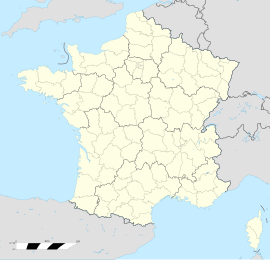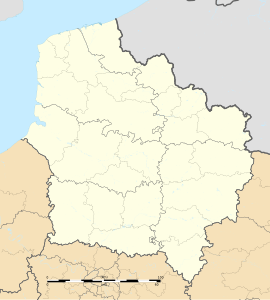Doullens (French pronunciation: [dulɑ̃]; Picard: Dourlin; former Dutch: Dorland) is a commune in the Somme department, Hauts-de-France, France.
Doullens | |
|---|---|
 The town hall in Doullens | |
| Coordinates: 50°09′27″N 2°20′29″E / 50.1575°N 2.3414°E | |
| Country | France |
| Region | Hauts-de-France |
| Department | Somme |
| Arrondissement | Amiens |
| Canton | Doullens |
| Intercommunality | CC Territoire Nord Picardie |
| Government | |
| • Mayor (2020–2026) | Christelle Hiver[1] |
Area 1 | 33.4 km2 (12.9 sq mi) |
| Population (2021)[2] | 5,835 |
| • Density | 170/km2 (450/sq mi) |
| Time zone | UTC+01:00 (CET) |
| • Summer (DST) | UTC+02:00 (CEST) |
| INSEE/Postal code | 80253 /80600 |
| Elevation | 52–152 m (171–499 ft) (avg. 64 m or 210 ft) |
| 1 French Land Register data, which excludes lakes, ponds, glaciers > 1 km2 (0.386 sq mi or 247 acres) and river estuaries. | |
Its inhabitants are called Doullennais and Doullennaises.
Geography
editDoullens is situated on the N25 road, in the northern part of the department, straddling the river Authie, the border with the Pas-de-Calais. Doullens is practically mid-way on the intersection of these axes :
History
edit- Doullens, the ancient Dulincum, was seat of a viscountship under the counts of Vermandois then of Ponthieu (Hare) and an important stronghold in the Middle Ages.[3]
- In 1225, the town became part of France.
- In 1475 it was burnt by Louis XI for openly siding with the Duke of Burgundy.[3] It received its name Doullens-le-Hardi from its gallant defense in 1523 against the Anglo-Burgundian army.
- In 1595 it was besieged and occupied by the Spaniards, who massacred the entire population. It was restored to France by the Peace of Vervins (1598).[3]
- On 26 March 1918, orders giving General Foch overall command of the allied forces on the western front were signed in a room in the town hall. A link to those orders can be found in the May 22, 1928 edition of 'The Times' of London, found here.
Sites and monuments
editSites and monuments include:
- the ruins of Saint-Pierre, partly of the 13th century, used as a barn in the nineteenth century (Hare).
- Notre-Dame church.
- An early 17th century brick belfry. In 2005, the belfry was inscribed on the UNESCO World Heritage List as part of the Belfries of Belgium and France site, because of its architecture and historical testimony to the rise of municipal power in the area.[4]
- the citadel, possibly built by Vauban or Jean Errard, which has often served as a state prison, and later, a reformatory for girls.
Town motto
editInfinita decus lilia mihi prestant
Population
edit| Year | Pop. | ±% p.a. |
|---|---|---|
| 1936 | 5,770 | — |
| 1946 | 5,404 | −0.65% |
| 1954 | 6,169 | +1.67% |
| 1962 | 6,321 | +0.30% |
| 1968 | 7,119 | +2.00% |
| 1975 | 7,495 | +0.74% |
| 1982 | 7,054 | −0.86% |
| 1990 | 6,615 | −0.80% |
| 1999 | 6,279 | −0.58% |
| 2007 | 6,339 | +0.12% |
| 2012 | 6,643 | +0.94% |
| 2017 | 6,106 | −1.67% |
| Source: EHESS[5] and INSEE (1968-2017)[6] | ||
Notable residents
edit- The artist Édouard Traviès was born in Doullens in 1809.[7]
- Louis Auguste, Duke of Maine was imprisoned in the Doullens citadel from 1718 until 1720 for his part in the Cellamare conspiracy.[8]
- The nobleman Emmanuel Marie Michel Philippe Fréteau de Saint-Just was imprisoned in the citadel in 1788.[9]
Gallery
edit-
Church of St-Pierre
-
Notre-Dame church
-
Belfry and Tourist office
-
Interior of the Citadelle
-
Notre-Dame church seen from the Citadelle
-
Doullens belfry, in the 19th century
-
Information placard of the Citadelle
-
Summer Carnival in Doullens (2009)
See also
editReferences
edit- ^ "Répertoire national des élus: les maires" (in French). data.gouv.fr, Plateforme ouverte des données publiques françaises. 13 September 2022.
- ^ "Populations légales 2021" (in French). The National Institute of Statistics and Economic Studies. 28 December 2023.
- ^ a b c One or more of the preceding sentences incorporates text from a publication now in the public domain: Chisholm, Hugh, ed. (1911). "Doullens". Encyclopædia Britannica. Vol. 8 (11th ed.). Cambridge University Press. p. 449.
- ^ "Belfries of Belgium and France". UNESCO World Heritage Centre. United Nations Educational, Scientific, and Cultural Organization. Retrieved 5 November 2021.
- ^ Des villages de Cassini aux communes d'aujourd'hui: Commune data sheet Doullens, EHESS (in French).
- ^ Population en historique depuis 1968, INSEE
- ^ Bellier de La Chavignerie, Émile and Auvray, Louis (1885). Dictionnaire général des artistes de l'École française depuis l'origine des arts du dessin jusqu'à nos jours, Vol. 2, p. 588. Librairie Renouard (in French)
- ^ D'Harmonville, A. (ed.) (1845). Dictionnaire des dates, des faits, des lieux et des hommes historiques, Vol. 2, p. 255. Alphonse Levavasseur et Cie (in French)
- ^ Assemblée nationale de France. "Emmanuel, Marie, Michel, Philippe Fréteau de Saint-Just" Retrieved 15 May 2017 (in French)
- Augustus Hare, North-eastern France 1896:76.
External links
editWikimedia Commons has media related to Doullens.
- Official commune site Archived 2011-02-09 at the Wayback Machine (in French)
- Site of the tourist office (in French)
- Photos (in French)



